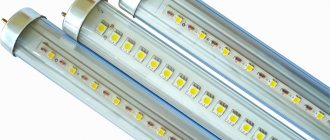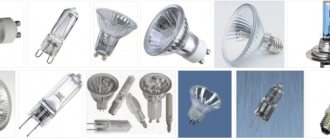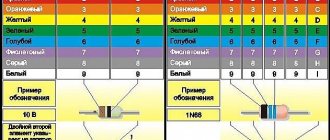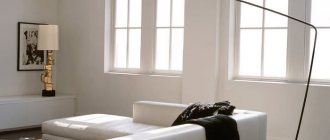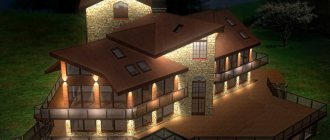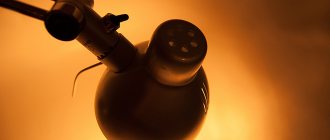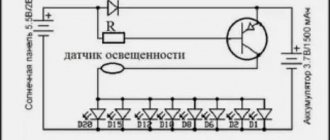Proper room lighting creates comfort and helps maintain a person’s physical and psychological health.. Light affects the perception of objects, the mood and activity of people, so the nuances of lighting design are thought through before installing the ceiling structure. Options for lighting a stretch ceiling make it possible to develop and implement unusual design solutions without neglecting comfort.
General information about suspended ceilings with lighting
Installing the canvas allows you to completely redesign the lighting in the room. Instead of the usual chandelier, there may be built-in lamps or a multi-level design with lighting. The choice is limited only by imagination and budget.
Before installation, determine the texture of the material, which comes in 3 types:
- Glyantsevoy. Mirror surface that reflects light.
- Matte. The canvas is similar to a classic ceiling: there is no glare from light sources.
- Satinova. Smooth texture providing soft reflection with a slight pearlescent effect.
Taking into account the characteristics of a particular ceiling material, lighting devices are selected.
Advantages
Stretch ceilings, compared to plasterboard ceilings, have the following advantages:
- Easy care. There is no need to putty or tint, and dirt can be removed with a dry or damp cloth.
- Eco-friendly materials. They do not allow dust and moisture to pass through, and are not afraid of corrosion and condensation.
- Easy installation and dismantling. The structure is installed in a few hours, and if the ceiling needs to be removed, its performance properties will be preserved.
- Variety of colors and shapes. You can make a green ceiling, a multi-level black one, or combine different shades and shapes.
Installation of spotlights
When choosing a lighting option for suspended ceilings, experts recommend using low-power products so that they do not harm the canvas. Hidden models are best purchased from well-known manufacturers. The lamps are placed so that the flow of light falls on the floor.
When installing lamps, proceed with extreme caution so that the fabric is not damaged. For this work you will need: a knife, glue and a lighting device. An acrylic box and special rings are also required. All communications must be laid before installation.
Installation sequence:
- Set up a profile. At the required height, attach the box under the lamp. There must be a nut on it to adjust the height. The lower edge of the box is placed no lower than the level of the tension fabric.
- In order not to forget the installation locations, they are marked on the floor with a laser. Next, the fabric of the structure is stretched.
- The center of installation of all lamps is marked on the PVC film, then glue is applied and the mounting ring is attached.
- A hole is cut out in its central part, through which the height of the box is adjusted, and the light source is placed in it.
Basic rules for lighting on suspended ceilings
When designing lighting design, you need to follow simple recommendations:
- Keep in mind that lighting must perform its main function. With any design, the main thing is a sufficient amount of light. Technical character cannot be neglected in favor of aesthetics.
- Maintain a uniform color temperature. This indicator is measured in degrees Kelvin and varies from 1,000 to 10,000 K. In everyday life, the concepts of “warm” and “cold” light are used.
- Avoid direct contact of the light source with your eyes. Lamps should not dazzle or interfere.
Lighting calculation
Recommended illumination indicators are specified in the set of rules 52.13330.2016, applied for the construction and operation of buildings (see table). Using accepted standards, calculations are made showing how much light is enough for the room.
| Room type | Illumination standard, Lux |
| Kitchen, living room | 150 |
| Children's | 200 |
| Bathroom, toilet, corridor | 50 |
| Wardrobe | 75 |
| Cabinet | 300 |
| Ladder | 20 |
| Sauna, swimming pool | 100 |
Illumination is measured in lux (Lx), and luminous flux is measured in lumens (Lm). 1 lux is equal to 1 lumen per 1 square meter, i.e. 1 Lx = 1 Lm/sq.m. To calculate, you need to multiply the area of the room by the norm from the table. For example, for a kitchen of 14 sq.m. you will need 2100 Lux: 14*150=2100 Lux. Based on the luminous flux characteristics given below, the required number of lamps is determined.
Design Feature
The fact is that suspended and stretch ceilings are not able to withstand the weight of conventional chandeliers and lamps, and they also do not fit so easily into the style of rooms, unlike ceiling lamps.
Thus, built-in lighting opens up a wide field of action for the implementation of any design ideas without losing such qualities as ergonomics and practicality.
The design of recessed luminaires is very simple and consists of several elements:
- Lamp;
- Frame;
- Fastening.
The second element, in turn, consists of a cartridge, for the manufacture of which materials such as porcelain or plastic with a high level of heat resistance, a light reflector and a diffuser are used.
There are several types of ceiling lamp designs:
Spot. Designs of spotlights can most often be found in homes; they have earned a good reputation among consumers due to their affordable cost and ease of use.
The constituent elements of point models include a reflector, a lamp and a housing.
At the same time, their most important advantage is that the body combines the properties of a decorative element and fastening. Turned lamps can be used both as main lighting and additional lighting.
- Hanging. Over time, these types of lamps lose their popularity among users, since a prerequisite for their installation is a hard ceiling covering. The suspended structure has a square shape and is mounted in the ceiling.
This type of lamp can only be used as main lighting due to the wide surface of the light element.
- Linear. Linear lighting sources allow you to create the longest rows of lamps; they have a fairly simple suspended design and are widely used in industrial premises.
- Spots. The design of spots is significantly different from other types of ceiling lamps. Translated from English, the name of these devices means “spot”, and indeed, this type of lighting allows you to create a specific light area using a directed beam of light.
The design of the spot is equipped with a frame with shades equipped with a rotating mechanism, a lamp and fastenings in the form of brackets. Spots can be mounted on the ceiling or wall.
Recessed lighting fixtures may differ in shape and are:
- Round. Designs of various sizes can be used both to illuminate large surfaces and to create narrowly focused light fluxes;
- Square or rectangular , designed to illuminate various areas;
- Strip lamps are used to illuminate individual elements and allow you to create fancy forms of lighting.
Lighting selection criteria
Tensile structures are made of fabric and PVC film.
Each material has distinctive characteristics:
- Fabric sheets have an artificial base, are breathable, and are resistant to temperatures of -40...+80°C. Such ceilings are installed even in rooms without heating. Disadvantages include high cost and lack of waterproof properties.
- Film sheets are waterproof, inexpensive, and can withstand repeated installation and dismantling. PVC ceilings cannot be installed in houses without heating, and at temperatures above +60°C they are deformed (when cooled, they are restored).
PVC products use lighting elements no more powerful than 35 W. There are no power limitations for tissue.
Lighting devices have different technical and aesthetic characteristics that must be taken into account when creating the design and functionality of the lighting.
Recessed, semi-recessed or surface-mounted lamps
Depending on the type of installation, luminaires are:
- Mortise. The device body and lamp are located in the interceiling space.
- Semi-mortise. The light source protrudes relative to the ceiling line.
- Invoices. They look like mini chandeliers and have hanging design elements.
Point: fixed or rotating
Based on the direction of the light flux, built-in lamps and spots are divided into:
- Fixed. The direction of the light does not change, the beam falls straight.
- Rotary. You can change the angle of the lamp or rotate it in different directions.
Focused or diffuse light
Depending on what kind of atmosphere needs to be created, the intensity and nature of the glow are selected.
Focused light, which is formed by a directed flow from a line of spotlights, LED strip or track spots, helps to highlight any area. With this approach, unlit objects will fade into the background, focusing attention on the main thing in the interior.
Drawing up a lighting scheme
To find out the number of lighting fixtures, you should decide on the lighting option for the stretch ceiling and only then on their placement diagram. If you plan to install a central chandelier, then the remaining lamps are placed where part of the room will not be covered by the main light flux.
Typically, these lighting devices are placed where there are dark areas, or in places that require additional lighting, for example, above the work area - the kitchen table.
If you do not plan to install the chandelier, then before making light in the suspended ceiling, you need to calculate the required number of lamps, taking into account their technical indicators and the type of lighting fixtures. Their number depends on the installation location. If there is no need to arrange bright light, lamps are not placed there, but this is certainly done in other areas.
To find out the number of lamps, take into account important nuances that affect the degree of illumination:
- height of the walls in the room;
- room configuration;
- is it planned to install a chandelier or not;
- the presence of additional light sources.
When calculating lamps, they also take into account the following standard - the power of light bulbs is 20 W per 1 sq. m. The above calculation is relevant if there is no chandelier in the center of the room. By dividing the sum of the power of all devices by the area, they will find out whether there is excess brightness - in this case, the result exceeds 20 W; if the resulting figure is less, then there will not be enough light in the room.
If you can’t do without a chandelier, then use a different formula, for which the power of the main light source is important. A chandelier usually illuminates a large area. In this case, point devices (spots) will function as local illumination. They are installed in areas where it is impossible to be without additional light.
When installing spots, the following rules are used:
- They are placed no closer than 30 centimeters apart.
- The distance between the wall and the nearest device should be at least 20 centimeters.
- In rooms with a ceiling height of less than 270 centimeters, the use of lamps with a power exceeding 35 W is not recommended.
When calculating, the type of lamps matters - for example, halogen lamps with a power of up to 35 W can illuminate 1.5 square meters. m. area. An 11 W energy saving light bulb can fill 1.5-2 square meters with light. m.
Types of luminous elements
When planning lighting design, methods of mounting lighting fixtures and their aesthetic properties are of particular importance. The colors, modifications, prices and quality available on the market allow you to choose the optimal solutions for each room.
Spotlights
These are lighting elements common for tensile structures, which are distinguished by their small diameter and directional beam of light.
Due to their compactness, such lamps can be used in almost any, even limited space: in a closet, pantry, under the stairs.
Invoices
Fixed lighting fixtures that protrude along the ceiling line but do not hang down are classified as overhead lighting fixtures. Their distinctive properties: ease of installation, variety of modifications and colors, low price.
Recessed lighting
Many manufacturers of suspended ceilings offer light boxes integrated into the design. They are frames with LED strip built into the canvas. This type of lighting is used in modern interiors.
Hanging chandeliers
Familiar ceiling chandeliers come in a variety of shapes and sizes and harmoniously complement both classic and new-fangled renovations.
A place is allocated for the chandelier in advance, because after installing the ceiling, it will no longer be possible to change its location.
When installing, take into account that the distance from the lamp to the tension structure is at least 30–60 cm.
LED types of lamps
Lighting fixtures with LEDs, due to their low heat transfer, are optimally suited for fabric and film materials. Lamps can be built-in or overhead, rotary or fixed. The only difference between them is the “filling”, consisting of several connected LEDs.
Lighting accents
Lighting fixtures allow you to focus attention on different interior items. For example, an LED strip will help highlight the geometry and contours of the living room. It is attached to special cornices or to vinyl sheeting using double-sided tape. The diodes glow brightly and are also economical.
When creating lighting for suspended ceilings, the lamps are either placed on top or recessed into the canvas. The glow of built-in ceiling fixtures is diffused and soft, which is important for bedrooms and individual areas in rooms.
Subdued light is used to create original compositions on the ceiling surface, to organize night light, and is used for niches and arches. If you direct the lamp at certain parts, the beam will be concentrated and bright.
Spots and pendant lamps can be adjusted and thereby correct the direction of the light flow. They are used to highlight indoor work areas or interior items.
Popular lamp manufacturers
There are dozens of items on the packages of light bulbs. Products of certain brands differ in the technologies used in production and in cost.
According to the rating compiled at the beginning of 2022, the top 5 best brands included Philips, Osram, Gauss, Feron, Camelion. Lamps from these manufacturers are reliable, have a long warranty period, and a high price. There are many models.
The top 10 is completed by ASD, Navigator, Jazzway, Era and Kosmos. Their light bulbs are distinguished by low prices, long service life, and availability. However, marriage is more common among them than among the leaders of the rating.
How to choose?
To make the right choice, safety requirements must be taken into account. If there is insufficient ventilation, spotlights can catch fire and damage the ceiling covering. To avoid this situation, it is recommended to install only high-quality models with LED lamps.
If you decide to give preference to other light elements, you need to pay attention to their power. Halogen lamps 35-50 Watt or incandescent lamps up to 60 Watt are suitable.
It is also important to consider the design, color and material of the lamps, since in addition to the main function, lighting plays a decorative role in the interior. You can diversify the decor of a spacious room and make it more comfortable with unusual overhead spot products.
To decorate a small room, it is advisable to choose small built-in appliances that match the shade of the ceiling. Thus, inconspicuous spot lighting will not affect the surrounding interior in any way.
How to install suspended ceiling lamps
Before installation, they decide how many lighting fixtures there will be and how they will be located. Then electrical wires are laid in the interceiling space and platforms are attached on which the lamps will be held.
There are several installation features that should be taken into account when developing a project:
- the distance of the devices from the wall should be about 60 cm;
- the light fluxes of adjacent lamps should not intersect;
- Be sure to use thermal rings to protect the film around the product from overheating.
Taking style into account
When choosing lighting for the ceiling, you should also take into account the style of the room:
- The same type of lamps is not the rule. More attention is paid to their functionality. Minimalism usually uses bright, simple-shaped lamps. Illumination in a wooden ceiling (loft) is organized using industrial-style chandeliers. Non-standard steel models fit perfectly into high-tech and modern interiors.
- Along with providing lighting, you can use ceiling lamps to zone the room. In this case, pendant lighting fixtures are used, which are positioned at different heights.
- Spotlights are usually equipped with those areas that need special attention. We are not always talking about some significant element: built-in ceiling lighting is often installed at the head of the bed, taking care of a separate switch.
All of the above styles allow for the use of spot lighting to distract attention from unsightly areas.
Recommendations for lighting design
Modern interior solutions combine several types of lighting to create a cozy atmosphere at any time of the day. To do this, LED lighting is built in, which creates a soft light and has many applications.
Along the perimeter
Installing an LED line along the walls is called contour lighting. It visually expands the space and creates the effect of a “floating ceiling”.
Inside
They equip the entire area of the canvas with illumination “from the inside” or create figures and drawings from LED strips, which, when turned on, convey an unusual design.
Starry sky
This effect is created in 2 ways:
- In the space behind the ceiling, light guide threads (fiber optics, needle elements) powered by a light generator are placed in a chaotic manner.
- LEDs illuminate the canvas depicting the starry sky.
Correction of space with light
A suspended ceiling structure takes a few centimeters from the height of the room. Since most apartments are small, such systems visually reduce the space. A light on a suspended ceiling will help solve this problem.
If you direct the light flux from a chandelier and additional lighting devices to the ceiling, it will appear higher than in reality. The best effect is obtained on glossy vinyl sheets.
When a glossy film is installed in the living room, and a sconce is installed on the wall, the light of which is directed upward, the illusion of a floating ceiling appears, and the space seems more voluminous.
LED strips help adjust the geometry of the room. Since they are flexible, they allow you to implement any design of lighting on a stretch ceiling. The tape is hidden in the ceiling cornice, which makes it possible to correct the geometry. It is also used to emphasize steps in a multi-tiered structure. If the transitions are not highlighted, they will not look three-dimensional, as required by the design, and the levels will merge together.
Types of suspended ceilings with unusual lighting: ideas and options for different rooms
Unusual lighting emphasizes the interior of the room and creates a unified design style.
Children's
In rooms for small children, colorful ceilings with drawings or imitation of the sky look appropriate. For teenagers, motifs from their favorite films or books are suitable.
Living room
The hall is most often the largest room in a house or apartment. Therefore, experiments with levels or canvases with illuminated drawings look good. An interesting find is curtain lighting.
Bedroom
In a room intended for sleeping, lamps with adjustable light, as well as a canvas with a starry sky effect, look harmonious.
Bathroom
The bathroom and shower do not require a lot of light, so you can diversify the color of the lighting and focus on the mirror.
Corridor
A small corridor space is enlarged with the help of lighting along the contour of the ceiling.
Kitchen
The dining area, highlighted by light directed from hanging chandeliers or spots, and the cooking area highlighted by small lamps look unusual.
Specifics
When selecting ceiling lighting, the individual characteristics of the room are taken into account. For example, rooms with low ceilings or beam structures will require a special approach. In the first case, it is advisable to use built-in lamps, which will make the room visually higher. It is recommended to equip beam surfaces with a chandelier in a rustic or loft style, focusing on the interior of the house.
The currently fashionable perimeter ceiling lighting is not suitable for every situation. It happens that a series of spotlights looks much more beautiful than hidden strip lighting. First of all, this applies to large premises. This approach will allow you to illuminate all corners evenly.
When arranging the ceiling lighting, drawing up a preliminary plan for the placement of wiring and light bulb installation points helps you not to lose sight of important points. It is important to understand that spontaneity will not work in this case, because... Most hanging systems require the laying of communications and the arrangement of niches for lamps at the stage of frame construction. Mistakes made at this stage are fraught with serious consequences: it is often necessary to dismantle the decorative canvas or slabs in order to correct the mistakes. The need for additional strengthening of areas where lamps or chandeliers will be placed should be taken into account.
Classification by type of light bulbs
Recessed ceiling lights have lamps in their design, which, in turn, differ in the degree of brightness, heat release and light temperature. There are:
- Incandescent lamps - despite their fairly low cost, incandescent lamps have a number of disadvantages. These include high levels of electricity consumption and heat generation, which over time lead to deformation of ceiling structures and increased monthly payments for light.
- Halogen lamps - this type of lighting elements can often be found in spotlights. The cost of these lamps is average, but the fact that the halogen elements get very hot introduces several restrictions on the use of lamps.
Firstly, the permitted power should not exceed 40 watts to avoid high temperatures, and secondly, it is not recommended to touch the lamps with bare hands, this can lead to defects due to epithelial particles and fat getting on the surface of the quartz glass.
- Fluorescent lamps - this type uses a chemical reaction of mercury and gas in its work, resulting in a luminescent effect. The advantages of such lamps include a high level of luminous efficiency and a long service life.
- Energy-saving lamps - the main features and advantages of these lamps are energy saving and low cost, but due to the design features they are used mainly for outdoor lighting. Overall dimensions, coupled with a high level of heating, do not allow the widespread use of energy-saving elements.
- Light-emitting diode or LED lamps are the crown of energy saving and productivity; their efficiency is ten times higher than that of other types of lamps.
